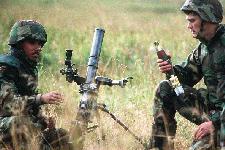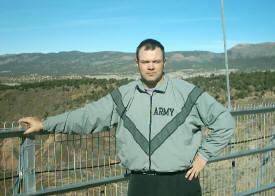Tube Worms
 Here is some basic information about the light infantry mortar. Please note that this information can be found on the net from a variety of sources so to the best of my knowledge this is not a violation of Operational security. The M224 60mm LWCMS is ideally suited to support airborne, air assault, mountain, ranger, Special Operations Forces and light infantry units. The M224 can be drop fired (conventional mode) or trigger fired (conventional or hand-held mode). A lightweight auxiliary base plate is used when firing the mortar in the hand-held mode. The M224 60mm Lightweight Mortar is a smooth bore, muzzle loading, high-angle-of-fire weapon. The cannon assembly is composed of the barrel, combination base cap, and firing mechanism. The mount consists of a bipod and a base plate which is provided with screw type elevating and traversing mechanisms to elevate/traverse the mortar. The M64 sight unit is attached to the bipod mount via a standard dovetail. An additional short range sight is attached to the base of the cannon tube for firing the mortar on the move and during assaults. It has a spring-type shock absorber to absorb the shock of recoil in firing. The M224 replaced the older (WWII era) M2 and M19, 60mm Mortars. These weapons only possessed 2,200 yards of effective range. The M224 was designed to fire all types of the older ammunition, but its primary rounds are of the newer, longer-range type. Mortars can provide a heavy volume of responsive, accurate fire with a variety of ammunition. They are ideal for attacking close in targets, targets on reverse slopes, and those targets in areas difficult to reach with low angle fire. Mortars are particularly effective in providing white phosphorous and illumination support. Mortars are transported by vehicle, helicopters, or by man pack. Mortars can be man packed in terrain where vehicular support is restricted. However, in a fast moving operation, the mobility of mortars, coupled with their limited range capability, may be a restricting factor. Mortars also have the capability to be fired from a light armored vehicle Mortar fires can be massed on a target by the organic unit. However, massing of mortar fires outside the zone of action of the organic unit is difficult due to the limited range of the mortar. Responsiveness is an inherent characteristic of mortars. The high angle trajectory and long time of flight causes the mortar to be vulnerable to enemy counter fire. Active and passive measures are used to increase survivability. Because ammunition for mortars may have to be man packed, the sustainment of mortars may be difficult. So mortars should be employed as an immediately available source of fire support for the infantry commander. Other indirect fire weapons are used when they can achieve the desired results. The 60 mm mortar section employs three mortars. When the mortar section is in General Support [GS], it supports all rifle platoons as directed by the company commander. By keeping the section in GS the company commander retains flexibility, ease of coordination of fires, and the ability to mass fires. Direct tactical control of the section remains with the weapons platoon commander. Fires are controlled from the company command post when observation of the entire company zone of action is possible from that position. If not, the mortar section leader mans an observation post to control the fires. GS is the preferred method of employment. The mortar section may be employed in Direct Support [DS] of a specific unit of the company; e.g., a rifle platoon. The section leader establishes direct liaison with the supported rifle platoon commander and conducts fire missions as requested by him. The weapons platoon commander is responsible for the control of the section’s actions to include positioning and displacement. The mortar section, or an element thereof, may be attached to a rifle platoon. Attachment is justified when the mortar section cannot give adequate support to a rifle platoon by operating in GS or DS. Situations for attachment arise when a rifle platoon is: Operating as the advance party in an approach march; operating as a patrol whose route takes it out of mortar range; or conducting a withdrawal or is situated in a platoon strong point. When a mortar squad is attached to a rifle platoon, the rifle platoon commander assumes the tactical command, supply, and administrative functions normally exercised by the weapons platoon commander. Attachment is the least desirable method of employment. The employment of separate mortar squads attached to individual platoons lessens the destructive power achieved by consolidating the section. Attachment also increases the problems associated with ammunition distribution and re supply and a mortar without ammo is nothing more than an awkward club, as well as fire control.
Here is some basic information about the light infantry mortar. Please note that this information can be found on the net from a variety of sources so to the best of my knowledge this is not a violation of Operational security. The M224 60mm LWCMS is ideally suited to support airborne, air assault, mountain, ranger, Special Operations Forces and light infantry units. The M224 can be drop fired (conventional mode) or trigger fired (conventional or hand-held mode). A lightweight auxiliary base plate is used when firing the mortar in the hand-held mode. The M224 60mm Lightweight Mortar is a smooth bore, muzzle loading, high-angle-of-fire weapon. The cannon assembly is composed of the barrel, combination base cap, and firing mechanism. The mount consists of a bipod and a base plate which is provided with screw type elevating and traversing mechanisms to elevate/traverse the mortar. The M64 sight unit is attached to the bipod mount via a standard dovetail. An additional short range sight is attached to the base of the cannon tube for firing the mortar on the move and during assaults. It has a spring-type shock absorber to absorb the shock of recoil in firing. The M224 replaced the older (WWII era) M2 and M19, 60mm Mortars. These weapons only possessed 2,200 yards of effective range. The M224 was designed to fire all types of the older ammunition, but its primary rounds are of the newer, longer-range type. Mortars can provide a heavy volume of responsive, accurate fire with a variety of ammunition. They are ideal for attacking close in targets, targets on reverse slopes, and those targets in areas difficult to reach with low angle fire. Mortars are particularly effective in providing white phosphorous and illumination support. Mortars are transported by vehicle, helicopters, or by man pack. Mortars can be man packed in terrain where vehicular support is restricted. However, in a fast moving operation, the mobility of mortars, coupled with their limited range capability, may be a restricting factor. Mortars also have the capability to be fired from a light armored vehicle Mortar fires can be massed on a target by the organic unit. However, massing of mortar fires outside the zone of action of the organic unit is difficult due to the limited range of the mortar. Responsiveness is an inherent characteristic of mortars. The high angle trajectory and long time of flight causes the mortar to be vulnerable to enemy counter fire. Active and passive measures are used to increase survivability. Because ammunition for mortars may have to be man packed, the sustainment of mortars may be difficult. So mortars should be employed as an immediately available source of fire support for the infantry commander. Other indirect fire weapons are used when they can achieve the desired results. The 60 mm mortar section employs three mortars. When the mortar section is in General Support [GS], it supports all rifle platoons as directed by the company commander. By keeping the section in GS the company commander retains flexibility, ease of coordination of fires, and the ability to mass fires. Direct tactical control of the section remains with the weapons platoon commander. Fires are controlled from the company command post when observation of the entire company zone of action is possible from that position. If not, the mortar section leader mans an observation post to control the fires. GS is the preferred method of employment. The mortar section may be employed in Direct Support [DS] of a specific unit of the company; e.g., a rifle platoon. The section leader establishes direct liaison with the supported rifle platoon commander and conducts fire missions as requested by him. The weapons platoon commander is responsible for the control of the section’s actions to include positioning and displacement. The mortar section, or an element thereof, may be attached to a rifle platoon. Attachment is justified when the mortar section cannot give adequate support to a rifle platoon by operating in GS or DS. Situations for attachment arise when a rifle platoon is: Operating as the advance party in an approach march; operating as a patrol whose route takes it out of mortar range; or conducting a withdrawal or is situated in a platoon strong point. When a mortar squad is attached to a rifle platoon, the rifle platoon commander assumes the tactical command, supply, and administrative functions normally exercised by the weapons platoon commander. Attachment is the least desirable method of employment. The employment of separate mortar squads attached to individual platoons lessens the destructive power achieved by consolidating the section. Attachment also increases the problems associated with ammunition distribution and re supply and a mortar without ammo is nothing more than an awkward club, as well as fire control.
The M224 Mortar System consists of the following major components:
M225 Cannon Assembly (14.4 lbs)
M170 Bipod Assembly (15.2 lbs)
M7 Baseplate (14.4 lbs)
M8 Auxiliary Baseplate (3.6 lbs)





No comments:
Post a Comment